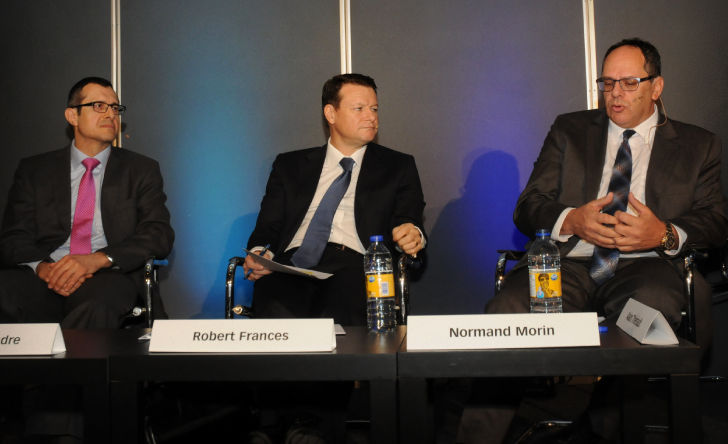A survey on the mandatory disclosure of mutual fund fees (CRM2) finds that one-third of advisors are missing an opportunity to strengthen their customer relations.
Unveiled as an exclusive at the 2016 Insurance and Investment Convention in November, the survey on advisors’ readiness for CRM2 stoked lively commentary from the three guest panelists at the event.
Conducted in October 2016 among Quebec-based advisors, the survey found that 30% of the 1,900 participants had not yet told their clients about the details of the obligatory disclosure that came into effect with phase 2 of the CRM.
Mutual fund and securities brokerage firms have until July 2017 to send their clients a document that spells out these fees. The panelists expect that many firms will be scrambling to send out the forms starting in January.
Manulife Investments CEO, Bernard Letendre, one of the panelists, attributes this result to advisor’s discomfort with talking about fees. “Advisors may not have raised this topic much in the past. When clients think that [the service] is free, it may be a little embarrassing to have to reveal that there’s a cost to it,” he said.
Normand Morin, CEO of Excel Private Wealth, thinks that the objective of CRM2 is to increase transparency, which is desirable. However, many clients already know how and how much their advisor is paid, through fees or embedded commissions. “If the compensation has already been explained well by the advisors, I don’t think the advent of CRM2 will pose a problem for advisors.”
He invites the other advisors, some of whom commented in the survey that their dealer would do the heavy lifting for them, to step up and assume their responsibilities. “The firm will disclose the fees but will not explain everything. It’s up to advisors to take advantage of their good relations with their clients to explain to them all the details about the fees and to clarify their compensation,” Morin added.
In response to an advisor’s comment “80% of my advisors have less than $10,000 in assets,” to explain why he had not acted yet, Morin said, “If the advisor has taken responsibility for a client’s account, he also is obliged to keep the client informed.” We should not assume that the dealer has explained the advisor’s compensation to the client at the start of the business relationship: “Off the bat, it is up to the advisor to explain to the clients how they are paid,” Morin continues.
PEAK Financial Group CEO, Robert Frances, thinks that the 30% who had not told their clients about CRM2 does not represent only advisors who are unaware of the issues. You have to delve deeper to explain why one-third of advisors have not discussed CRM2 with their clients, he says. From another perspective, he called the other 70% as being a very good result.
“Advisors say to me, ‘Talk about what? For years I have been telling clients about the cost of their investments,’” Frances says. “Particularly for those who charge fees, there is nothing new to announce.”
“Above all, clients want to know how much they made on what they invested in their accounts – the return net of fees,” Frances and Morin concluded.
Don’t wait …
More thought-provoking results: 40% of the advisors who had not yet talked to their clients about CRM2 said they were waiting until their firm sends out the reports to do this. On top of that, 15% say they want to wait for three months. Others said they want to wait until the end of the RRSP season, or even later.
Bernard Letendre said that advisors have to act quickly. “Don’t be shy to talk about fees. They reflect everything you do for the client. If you let your client think that the advice is free, you strip your service of all its value. We are the only professionals to be shy about this. We find it normal to pay fees to a lawyer, because we know what we get in exchange.”
Talk to clients in person
Letendre added that the industry talks about advice too little and about returns too much. “You are acting like financial coaches; your services go well beyond earning returns,” Letendre said. “According to the second version of the study by Claude Montmarquette, published by CIRANO last summer, an investor who works with an advisor for 15 years will have 290% more assets than one who does not. It is not market performance that will give the client more long-term assets; it’s the advisor who helped the client save more and remain invested during times of crisis.”
Of the 70% of advisors who say they discussed CRM2 with their clients, 95% did so in person. Many of the survey participants combined more than one method in their approach. For instance, 20% of advisors informed their clients about CRM2 by email.
Talking in person is the best approach, Morin says. “Face-to-face gives the client better access to important information. On the phone, we don’t have the same quality of conversation or presentation tools, and we know how essential it is for clients to be able to visualize, he explained.
Letendre suggests that advisors let clients choose the method. “Some clients tell us they prefer face-to-face, while others like to use the videoconferencing system Webex or online calls via Skype, he points out.
One advisor in the audience said he was worried that this disclosure may be too shocking because it is in dollars rather than percentage. Morin agreed. “Clients who see $3,000 or $4,000 in fees on their statement may be worried. The important thing is to bring up this topic before the clients receive this statement. It will give them time to react. Advisors can also make adjustments more easily, for example if the customer’s asset growth justifies going from embedded commissions to fees,” he said.
Positive to neutral reaction
Fewer than 38% of respondents describe their clients’ reaction to the announcement of CRM2 as neutral. “I’m surprised by that result. I guess those advisors took the initiative to inform their clients about the fees and their compensation before the obligation was announced,” Morin said.
All the same, he added that 57% reacted positively or very positively. “If we add the 38% neutral reaction to that, we’re left with very few dissatisfied clients.”







